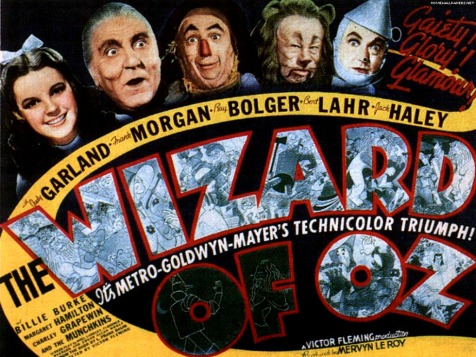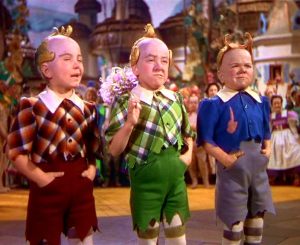My parents introduced “The Wizard of Oz” to me when I was a baby.
My sisters and I all have dressed up as Dorothy for Halloween or a book character day at least once.
We also have Dorothy Barbies, dolls and my mom owns “The Wizard of Oz” collectors decorative plates.
Needless to say, the Pickens family are fans of the film.
I grew up with “The Wizard of Oz” just as my parents did when it was shown yearly on television.
“The Wizard of Oz” was what taught me about the state of Kansas and what a cyclone was.
Like most movies, the information and lessons it taught me molded my young mind.
When I heard the 1939 film starring Judy Garland as Dorothy was going to be released in 3D and IMAX, I had mixed emotions.
1. I wanted to see the film on the big screen, because I never had before.
2. I don’t like 3D and avoid it at all costs. Why did they feel the conversion was necessary?
Though I wasn’t pleased with the thought of 3D or paying $17 for a movie ticket, I couldn’t pass up watching a classic film in a movie theater- something that doesn’t happen much in my area.

Ray Bolger as the Scarecrow, Bert Lahr as the Cowardly Lion, Judy Garland as Dorothy and Jack Haley as the Tin Man in “The Wizard of Oz”
Tuesday evening I made the 50 minute drive to Charlotte, NC to see the “Wizard of Oz.”
The Technicolor was lush, I laughed at the supporting characters, cried at the end of the movie and I enjoyed myself. It had been years since I watched “The Wizard of Oz” from start to finish. I forgot how funny the jokes are and how visually beautiful it is.
Having the opportunity to see a classic film on the big screen is a special experience. Even if you have seen the movie before, you pick up on jokes and subtle movements and expressions better than you can on your television. You are also forced to pay attention to the film, because it is just you and the screen.
But the big question is, was the 3D necessary or distracting?
The 3D wasn’t obtrusive or dramatic. Many scenes looked similar to if you were watching a 2D version of the film. The times it stood out the most were when the Wicked Witch (played by Margaret Hamilton) pointed at the camera or when Glenda the Good Witch (played by Billie Burke) gestured with her silver wand.
The 3D mostly was used for depth. Dorothy sat a little further out from her surroundings as she sang “Somewhere Over the Rainbow” and the Lollipop Guild stood out as well. These scenes weren’t bothersome, but there just wasn’t much purpose to it.
The only other 3D film I have watched in a theater the John Wayne film “Hondo” (1953) at the Turner Classic Film Festival. While the 3D wasn’t used excessively in “Hondo,” it’s use was more dramatic. Native Americans rode on horses towards the screen and arrows looked like they were coming at you.
There was nothing that dramatic in “The Wizard of Oz,” not even a flying monkey looking like it was going to share your seat.
There were a few times I felt 3D made things a bit blurry (or maybe it’s my bad eye sight) like when the Scarecrow (Ray Bolger), Dorothy (Garland), the Cowardly Lion (Bert Lahr) and the Tin Man (Jack Haley) ran through the poppy field. Another area I felt was a bit blurry was when Dorothy opened the door to Oz-taking the film for sepia tone to Technicolor.
In general, I’m not a fan of colorization of black and white films such as “It’s A Wonderful Life” (1946) or “Rebecca of Sunnybrook Farm” (1938). I feel that modifying a film from 2D to 3D falls under the same distasteful category as colorization. All of these tactics are to bring in younger audiences. But why change art? If a younger audience doesn’t like the “Mona Lisa” would we paint a smile on her?
“3D falls into the category of digital ‘remixing,’ colorizing and other changes,” said my broadcast journalism professor, Haney Howell. “The director shot the movie from his perspective, not that of some geek who thinks he can make it better.”

Buddy Ebsen was originally cast as the Tin Man but was allergic to the makeup. His big break came in the from of the 1960s TV show, “The Beverly Hillbillies.”
From 1938 to 1939, the script of “The Wizard of Oz” had several rewrites and stars were recast in the film. Shirley Temple was originally considered for the role of Dorothy. Buddy Ebsen was going to be the Tin Man but was allergic to the silver face paint, and Jack Haley was cast instead. Margaret Hamilton, who played the Wicked Witch of the West, received third degree burns on her hands and face during her firey exit with the Munchkins.
A lot of blood, sweat and tears went into the director’s vision of “The Wizard of Oz.” Modifying the film from 2D to 3D is going against artistic wishes.
When it was announced “Wizard of Oz” was going to be in 3D, it was said, “If 3D was around in 1939, this is how it would have been shot.” Which is a ridiculous response.
Filmmakers have had 3D capabilities of some sort since the 1920s and 1930s. MGM even made a short film in 1935 called “Audioscopiks” testings 3-D. Then 3D film fell briefly into the mainstream from 1952 to 1954. Hollywood was using 3D to pull movie goers away from their television screens and back into theaters.
So saying “If 3D was around” is a fairly ignorant response.
But to answer the $64 question of “Was 3D necessary?”: No, probably not. But so far, since “The Wizard of Oz” was released last Friday, it has made roughly $3 million. It has served the purpose the money making purpose it was supposed to.
Regardless, I really enjoyed seeing “The Wizard of Oz” for the first time on the big screenscreen.
But as Dorothy says, “If I ever go looking for my heart’s desire again, I won’t look any further than my own backyard. Because if it isn’t there, I never really lost it to begin with.”
The popularity of “The Wizard of Oz” has remained for over 75 years, so why look any further to improve on it when it isn’t needed.
Check out the Comet Over Hollywood Facebook page, follow on Twitter at @HollywoodComet or e-mail at cometoverhollywood@gmail.com




Excellent post and commentary. 3D has always and WILL always be a well-intentioned gimmick that yes, draws lots of interest and makes a fair amount of money for movie studios (and of late, game companies). But at the end of the day, it rarely changes the basic experience of watching (or playing) what a director and/or development studio has intended.
LikeLike
Great post! Hearing that the only thing the 3D really added was more depth makes me glad that I decided to skip seeing it. It seems like the vast majority of what I hear about movies post-converted to 3D is that the 3D adds depth and there are a few moments when that’s cool, but that’s about it. It may not be poorly done or obtrusive, but it’s not enough to get me to pay so much to see it again.
LikeLike
I agree that the 3D wasn’t necessarily, but thought it turned out surprisingly well (and I generally go out of my way to avoid 3D versions of films). The big screen image was awesome…I don’t recall having seen the Munchkins’ red-and-white violins before.
LikeLike
Great post and points! I love your comment about the 3D effect doesn’t make you feel like a flying monkey was about to share your seat. Made me laugh.
LikeLike
Great review! I’m not a big fan of 3D but I think I would watch Wizard of Oz in that format just to see what it looks like. I didn’t grow up with Wizard of Oz like you did so when I saw it for the first time as an adult I was a bit taken aback by how weird it was. However, I ended up reading the book, fell in love with the story and when I watched the film again I found I enjoyed it much more!
Great post, love all the history and trivia bits you added.
LikeLike
Wizard was one the Awesome movie.
LikeLike